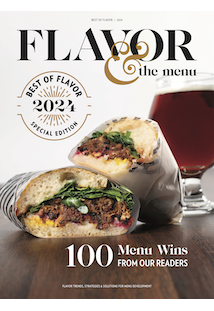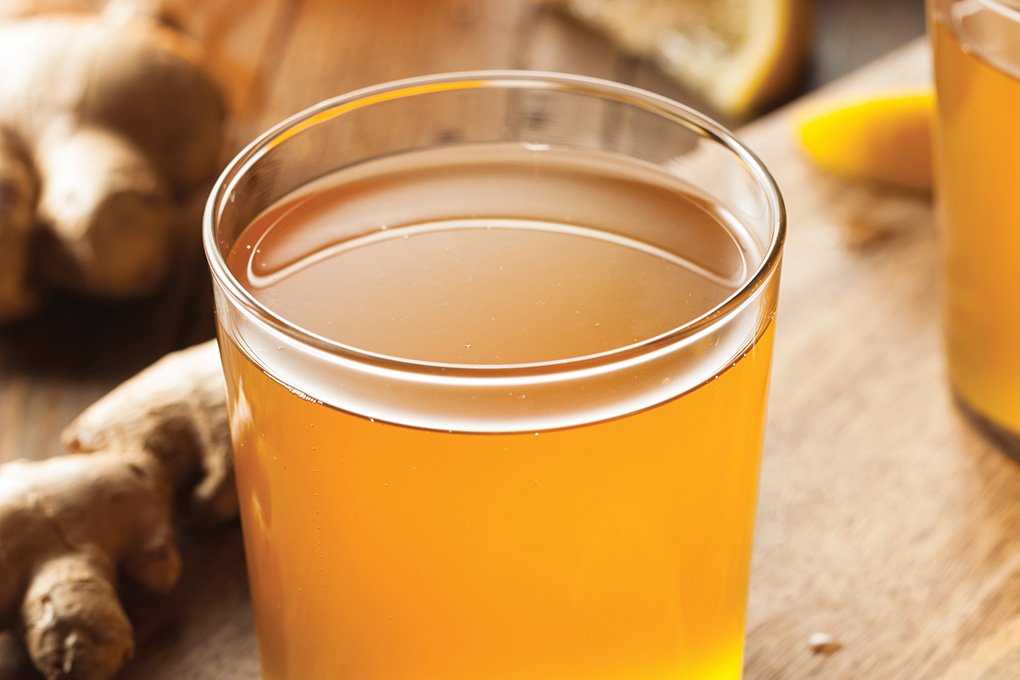Today, the exploration of pickled, fermented and preserved goes way beyond dropping a few pickled onions into a Gibson. From kombucha to kimchi, fermented foods and beverages have jumped from the health food counter to kitchen bench to bar top, adding complex flavor and tang to cocktails. Here are 10 trending agents of change.
1. Kombucha
A tangy fermented tea with immune-boosting antioxidants and digestive probiotics, kombucha is popular for its health benefits and its variety of fruit flavors, light carbonation and balance of sweet and tart. Kombucha makes for a bright mixer when combined with just about any spirit, or with other ingredients for a satisfying mocktail.
Rumbucha: Amber rum with honey-fig kombucha served with Sicilian spiced chicharrones
—L’Oca d’Oro, Austin, Texas
The Daily Routine: Pimm’s, housemade ginger syrup, lime, Baba’s Brew Asian Pear Kombucha
—24 Wood Fired Fare, Philadelphia
2. Switchel
Switchel, made with fermented vinegar, ginger and molasses, originated in the Caribbean cane plantations and was passed onto farmers of New England. It’s also known as haymaker’s punch (sweetened with maple or honey) because of its ability to quench belabored harvesters. Rum is the natural spike, but switchel also makes an excellent adult beverage with or without added spirits.
Urban Switch: Arroyo Vodka, housemade apple-basil switchel, agave nectar, Hornsby’s Hard Amber Cider Beer, garnished with dried apple chips
—District American Kitchen And Wine Bar, Phoenix
Storm Scout: House bourbon, barrel-aged apple-ginger-maple switchel, lime juice, Gosling’s Dark Rum float
—Montana’s Trail House, Brooklyn, N.Y.
3. Mead
Mead as the mythical “beer” poured into the tankards of Vikings by Renaissance wenches isn’t where the story ends. Modern meaderies and bartenders are bringing back the buzz with this fermented honey wine, not just as a lightly alcoholic base, but as a modifying flavor or delicate sweetener as well. Use it to make a classic but sessionable Bee’s Knees or hot toddy, or tap exotically floral mead for a bracing, cool concoction.
Nectarweiss: Wheat beer and Redstone Black Rasperry Mead
—Redstone Meadery, Boulder, Colo.
Pass The Mead: Chaucer’s Mead, Peychaud’s, muddled berries, topped with crushed ice and Montelliana Prosecco
—The Cocktail Club, Charleston, S.C.
4. Shrub
Shrub, the Colonial-era fruit that’s preserved or acidulated in vinegar, has been creeping onto mainstream cocktail lists for years. Shrubs in the form of drinking vinegar, syrup or even fermented to fizzy, can serve as fruit flavor, acid ballast or sweetening agent. Tangy shrubs are also a terrific base for mocktails as they can mimic the bright heat of spirited concoctions without contributing overly sweet notes.
Palmer Cazadores, blood orange shrub, Cocchi Rosa, blood orange
—Pasture, Richmond, Va.
Copper Hill: Copper & Kings Brandy, smoked apple shrub, walnut bitters, saffron bitters, fresh rosemary
—Venkman’s, Atlanta
5. Fruit Preserves
Preserving sweet summer fruits in sugar or spirits is an age-old kitchen tradition, but bartenders who want a housemade, local twist have learned that preserves are a handy tool for adding vibrant, deep flavor, silky texture and sweet-tart balance. It’s nothing new: The marmalade cocktail dates back to 1930, when The Savoy Cocktail Book (Martino Fine Books, 2013) paired marmalade with lemon juice and whiskey.
Gin & Jam: Cap Rock Gin, fresh lemon, Jam Stand Peachy Sriracha Jam
—Meat & Cheese, Aspen, Colo.
The Lamplighter’s Story: Plymouth Gin infused with hibiscus, grapefruit marmalade, Serrano chile, bitter orange soda, lemon
—White Chapel, San Francisco
6. Kimchi
It may have started with the Korean Bloody Mary, but spicy Korean fermented vegetables lend themselves to a variety of other spikes as well. Whole produce, purée and the juice or brine of the fermented preps blend beautifully with an off-dry gin or the blank palate of vodka, but even better with soju, Korea’s national drink. They become yin and yang twins of fermentation—spicy and sweet.
Chef’s Special: A Tiger Beer tall boy can with a shot of Evan William’s Black Label Bourbon and kimchi pickleback
—Ace Eat Serve, Denver
Kimchi Bloody Mary: Soju, kimchi juice, lime, bok choy-kimchi garnish
—Tree House, St. Louis
7. Pickle
Stuffing a pickle into a Bloody Mary is not the only way to get in a pickle at the bar. Now, we see vegetables, berries, citrus, tree fruits, shrimp, relishes, chutneys and old-fashioned pickle concoctions used as garnishes or to flavor the base spirit, modifier, or the drink itself. Try a rich, dark Branston pickle paired with a spicy rye for a bracing yet comforting combination, or a refreshing pickled lime version of the classic gimlet.
Hot & Dirty: Knockabout Gin, Sriracha, Maitland Mountain Farm Pickle Brine and pickle garnish
—The Lobster Shanty, Salem, Mass.
Pickles!: House-infused cucumber pickle vodka martini served straight up with house-pickled garnishes and a salted rim
—The Bad Apple, Chicago
8. Brine
Brines have come a long way from dirty martini land. Bartenders are dirtying drinks with craft pickles, preserved lemon and grape-must brines, kraut and kimchi juice. Though it stands to reason that these pair well with clear spirits like gin and vodka “picklebacks,” new comebacks extend to Scotch and mezcal—and more refined cocktails, too.
Der Schmutzige: Black pepper/mustard vodka with pickled beet and kraut juice
—Grünauer, Kansas City, Mo.
Dirty Aphrodite: Prairie Organic Vodka, Dirty Dill Pickle Brine
—Jacob’s Pickles, New York
9. Miso
The range of fermented, umami-rich miso offers untold savory twists to cocktails. Try aggressively flavored, long-aged red and black versions to shiro (white) misos, which are fermented for only a few weeks to let their beany sweetness shine through. Miso can be mixed or muddled in—or added in the form of a syrup, extract, liqueur or even caramel.
Miso Honey: White miso caramel, lemon juice, Laird’s Apple Brandy, Bärenjäger, five-spice mulled cider, fresh ginger
—Kuma’s Corner, Chicago
Foodbar Miso Mary: Horseradish tomato mix, savory miso, vodka and matcha-salt rim
—Food Bar Food, Harrisonburg, Va.
10. Spirits
Barrel- and bottle-aging anything now is buzzworthy. The rediscovery of barrel- and bottle-fermenting at the bar uncorks opportunities in flavor, quick preps, regulated-proof or low-alcohol preps that offer more complex, sessionable selections—or offer non-spirit licensees more range. Bottle- and barrel-fermenting with yeast can also create carbonations that make any ingredient more sprightly and flavorful.
Aged Lewis & Clark: House barrel-aged Kentucky rye, Carpano Antica and Meletti, served in a cherrywood-smoked glass
—23Hoyt, Portland, Ore.
Empress Chilltini: Premium Blend Klir Red distilled wine, elderflower, lychee and fresh basil
—Chillbar, Hollywood, Fla.










